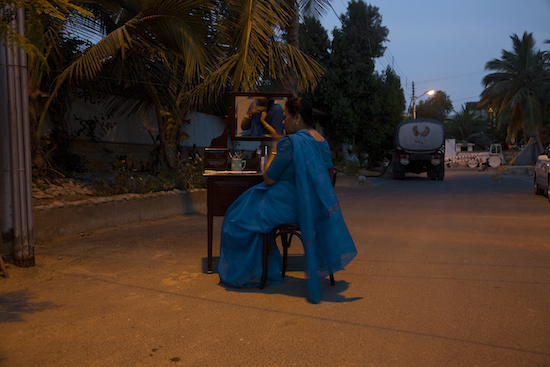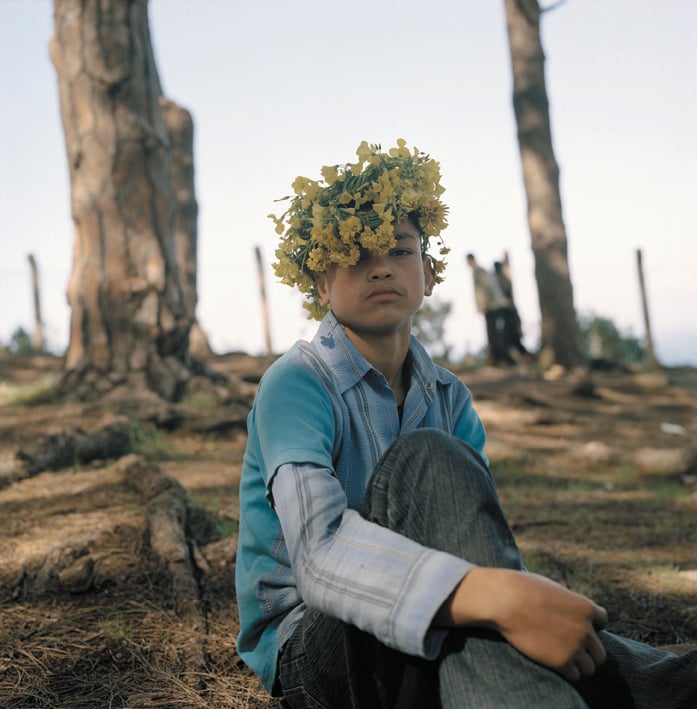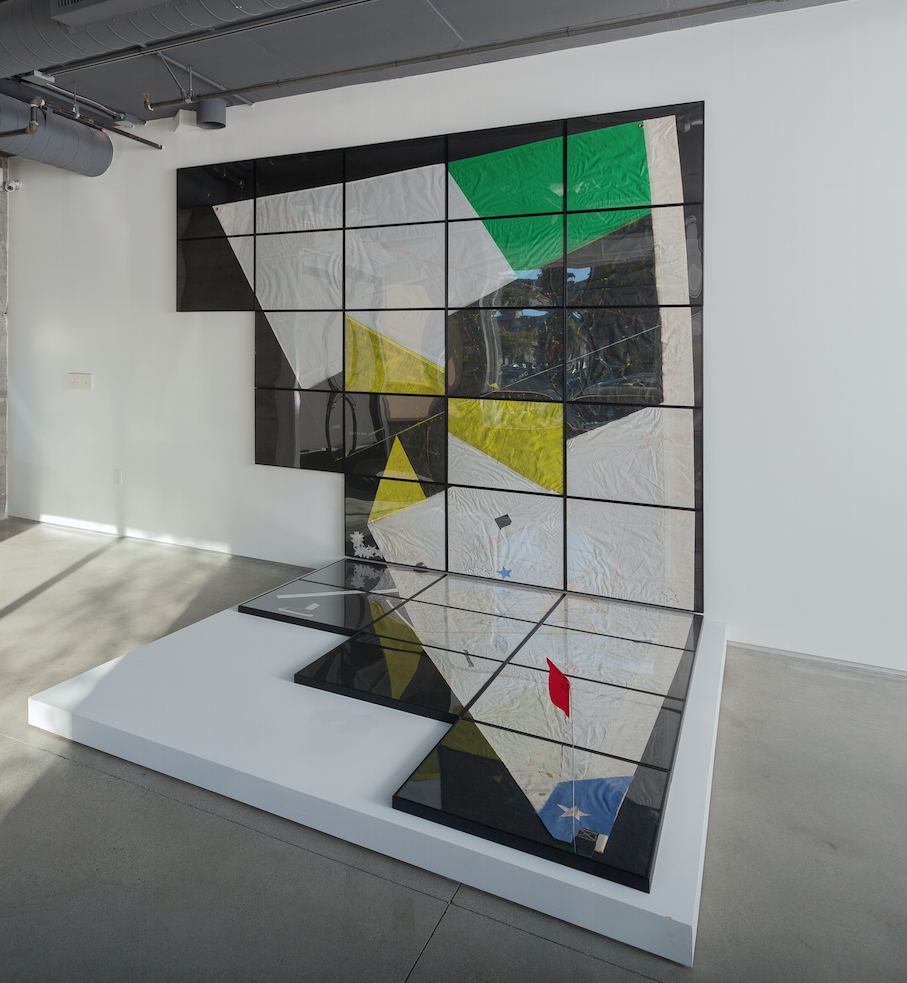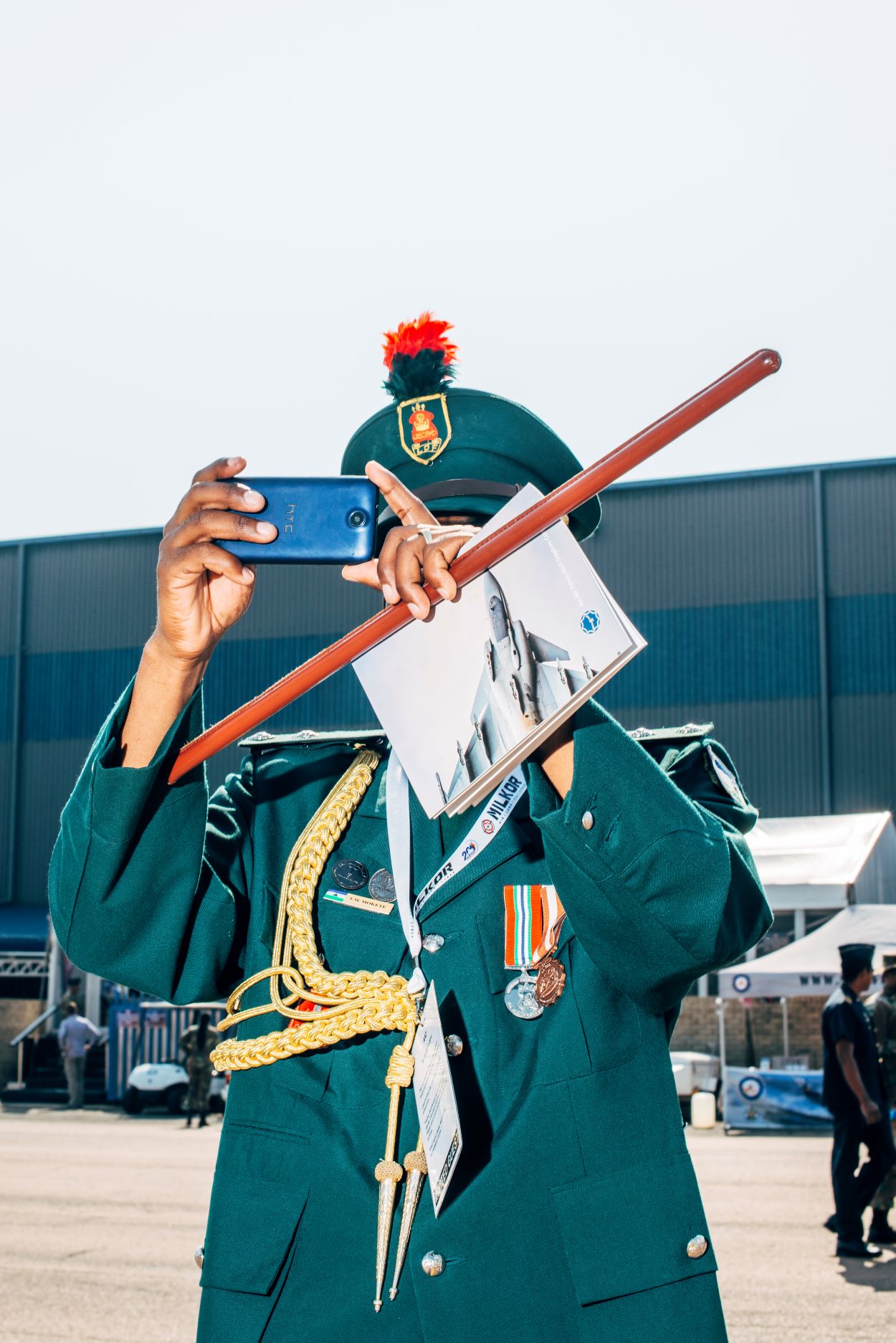
© » KADIST
Bani Abidi
The threshold in contemporary Pakistan between the security of private life and the increasingly violent and unpredictable public sphere is represented in Abidi’s 2009 series Karachi . These staged photographs were shot against the backdrop of the city’s empty streets at sundown during the holy month of Ramadan. During this time, Muslims fast and retreat indoors, leaving the city eerily empty.

© » KADIST
Shilpa Gupta
The three monkeys in Don’t See, Don’t Hear, Don’t Speak are a recurring motif in Gupta’s work and refer to the Japanese pictorial maxim of the “three wise monkeys” in which Mizaru covers his eyes to “see no evil,” Kikazaru covers his ears to “hear no evil,” and Iwazaru covers his mouth to “speak no evil.” For the various performative and photographic works that continue this investigation and critique of the political environment, Gupta stages children and adults holding their own or each other’s eyes, mouths and ears. These images suggest that seemingly mobilized societies can actually produce more fear and myths, and that no real freedom is ensured. Instead of facilitating the free circulation of ideas, “advanced” political and technological systems often generate more cultural clichés, wars, and terror.

© » KADIST
Shilpa Gupta
In Untitled (Sword) , addressing histories of colonialism with abstraction, a large steel blade extends from the gallery wall. Its severed tip dangles from the end of the blade by a string, floating just above the gallery floor.

© » KADIST
Shilpa Gupta
Drawing & Print (Drawing & Print)
These hand drawn maps are part of an ongoing series begun in 2008 in which Gupta asks ordinary people to sketch outlines of their home countries by memory. Gupta created each map by superimposing 100 separate drawings of each country. The project investigates modern notions of the nation-state, national identity, and borders by looking at countries in which boundaries are contested and the history of the land far precedes such ideas.

© » KADIST
Claudia Joskowicz
The primary interest in the trilogy is Joskowicz’s use of cinematic space, with long tracking shots that portray resistance to habitual viewing experiences of film and television. Video plays a role in the relation between the use of her locations and the stories of actual figures depicted as central in the frame. The meaning behind these historical icons such as Che and Cassidy, speak to their stories as itinerant figures whom traveled in a preglobalized era through borders and cultures in order to escape the law or overthrow it.

© » KADIST
Bani Abidi
The threshold in contemporary Pakistan between the security of private life and the increasingly violent and unpredictable public sphere is represented in Abidi’s 2009 series Karachi . These staged photographs were shot against the backdrop of the city’s empty streets at sundown during the holy month of Ramadan. During this time, Muslims fast and retreat indoors, leaving the city eerily empty.

© » KADIST
Bani Abidi
The perceived effortlessness of power, projecting above experiences of labored subordination is examined in Death at a 30 Degree Angle by Bani Abidi, which funnels this projection of image through the studio of Ram Sutar, renowned in India for his monumental statues of political figures, generally from the post-independence generation. In a contemporary Indian society beholden by strongmen, Abidi uses Sutar’s studio to fictionalize a sculptor producing commemorative works for populist, preening figures, surrounded by the likenesses of idolized politicians of the post-colony. Abidi’s video presents one such aspirational bureaucrat, trailed by a cadre of lackeys who fawn over the varying statues that are laboriously carted out for his approval.

© » KADIST
Claudia Joskowicz
The primary interest in the trilogy is Joskowicz’s use of cinematic space, with long tracking shots that portray resistance to habitual viewing experiences of film and television. Video plays a role in the relation between the use of her locations and the stories of actual figures depicted as central in the frame. The meaning behind these historical icons such as Che and Cassidy, speak to their stories as itinerant figures whom traveled in a preglobalized era through borders and cultures in order to escape the law or overthrow it.

© » KADIST
Claudia Joskowicz
The primary interest in the trilogy is Joskowicz’s use of cinematic space, with long tracking shots that portray resistance to habitual viewing experiences of film and television. Video plays a role in the relation between the use of her locations and the stories of actual figures depicted as central in the frame. The meaning behind these historical icons such as Che and Cassidy, speak to their stories as itinerant figures whom traveled in a preglobalized era through borders and cultures in order to escape the law or overthrow it.

© » KADIST
Xiaoyun Chen
The image of rusted nails, nuts and bolts as shrapnel sandwiched between a fried Chicken burger highlights the contrast between decadence and destruction. Chen emphasizes the direct sensational impact of his work to allow his viewer to question the boundary between reality and art. The image of nails as food harks at a visceral relationship with the title, which cries the tone of a manifesto.

© » KADIST
Shahzia Sikander
The Last Post was inspired by Sikander’s ongoing interest in the colonial history of the sub-continent and the British opium trade with China. In this animation, layers of images, abstract forms, meaning, and metaphorical associations slowly unfold at the same time that more visual myths are created. The identity of the protagonist, a red-coated official, is indeterminate and suggestive of both the mercantilist policies that led to the Opium Wars with China and the cultural authority claimed by the Company school of painting over colonial India.

© » KADIST
Xiaoyun Chen
The lengthy titles in Chen Xiaoyun’s work often appear as colophons to his photographs that invite the viewer to a process of self realization through contemplating the distance between word and image. Near his studio, Chen often walks over fallen branches in late autumn and sense their existence. Thus, his placing them in diverse contexts builds a “narrative Ariadne’s thread” where the branches become “the language of things” intertextually cohering his oeuvre.

© » KADIST
Yto Barrada
This photograph is part of the series titled “Iris Tingitana project” (2007) focusing on the disappearance of the iris. If Yto Barrada was initially interested in the architectural heritage of the city, today the core of her research focuses on risks around landscape and its heritage. The iris, found bordering the city, carries the name of the city, and is an emblem of Tangier.

© » KADIST
Claudia Joskowicz
Los rastreadores is a two-channel video by Claudia Joskowicz narrating the story of a fictitious drug lord, Ernesto Suarez, whose character is based on the well-known Bolivian drug dealer, Roberto Suárez. In the video, Suarez returns home from prison and survives a massacre that takes place at his home in Bolivia. Told in four chapters, the story is inspired by John Ford’s American Western classic film The Searchers (1956), this work similarly focuses on the politicized atmosphere of Bolivian history, searching for cues of race and alienation.

© » KADIST
Enrique Ramirez
Ramirez’s The International Sail is the fifth in a series that features an upside-down worn out, mended and fragmented boat sail. These works epitomize the idea of perpetual movement and migration while carrying a deep personal meaning in the creative process, as the artist’s father himself, still living in Chile, mends and sends the sails to his son, living in Europe. The reversed position of the sail recalls both the shape of South America itself and the Eurocentric view that in the Southern Hemisphere, everything is “upside-down.” The stitches themselves create an illusion of an alternative political geography, and the framed-cuts impose a cartographic grid.

© » KADIST
Xiaoyun Chen
The central point of Vanishing Point is the most direct physiological reaction of the body to the environment. Chen Xiaoyun has added a written narrative and a poetic quality to his works. Image fragments containing different pieces of information are linked together by the text, their interplay producing a synesthesia effect.

© » KADIST
Shilpa Gupta
Drawing & Print (Drawing & Print)
These hand drawn maps are part of an ongoing series begun in 2008 in which Gupta asks ordinary people to sketch outlines of their home countries by memory. Gupta created each map by superimposing 100 separate drawings of each country. The project investigates modern notions of the nation-state, national identity, and borders by looking at countries in which boundaries are contested and the history of the land far precedes such ideas.

© » KADIST
Xiaoyun Chen
State Terrorism in the ultimate form of Pre-Raphaelite Brotherhood features a portrait of the artist wearing a zipped utilitarian jacket reminiscent of a worker’s uniform, with one arm behind his back as if forced to ingest a bundle of stick—a literal portrayal to the definition of fascism. The title alludes to the Pre-Raphaelite notion of a brotherhood based on “truth to nature.” Censorship of the mouth and indigestion of freshly cut stalks, central to Chen’s language of tree branches, feeds back provocatively to the title’s suggestion of “state terrorism.” However, one must resist seeking symbolic meaning in the image as Chen’s focus is on the direct visual impact of the absurd act portrayed.

© » KADIST
Daniel Joseph Martinez
Martinez’s sculpture A meditation on the possibility… of romantic love or where you goin’ with that gun in your hand , Bobby Seale and Huey Newton discuss the relationship between expressionism and social reality in Hitler’s painting depicts the legendary Black Panther leaders Huey P. Newton and Bobby Seale. By using Carrara marble, a material usually associated with heroic public sculptures, Martinez casts the history of African-American revolutionaries into the artistic tradition of monumentality. Like the artist’s earlier work included in the 1993 Whitney Biennial, an interactive piece made up with pins that read, “I CAN’T IMAGINE EVER WANTING TO BE WHITE,” A meditation on the possibility… continues Martinez’s effort to expose cultural contradictions and increase public awareness.

© » KADIST
Claudia Joskowicz
Some Dead Don’t Make a Sound (Hay muertos que no hacen ruido) is a single-channel video by Claudia Joskowicz that features the Mexican legend of the Weeping Woman (La Llorona) as its main protagonist. The video begins with the image of a ghost-like female figure, representing La Llorona, slowly walking down a well-known street in Oaxaca, from the main square (el Zócalo) to the Teatro Macedonio Alcalá, with a painful expression on her face. According to this famous oral myth, the Weeping Woman drowned her two sons in a fit of grief and anger after her husband abandoned her.

© » KADIST
Yto Barrada
In this photographic series, Yto Barrada was interested in the logos of the buses that travel between North Africa and Europe. They become like abstract paintings that recall Modernist formal experimentation. They are somehow symptomatic of the circulation of goods and people that is made to sound so abstract.

© » KADIST
Xiaoyun Chen
In the video work Drag, a man in a dark room pulls on the end of a rope. In midst of sounds of heavy breathing, the camera presents alternating scenes of a man and the shadow of a man wearing a long, pointed hat cast against a wall. Insinuating a sinister mood, the man and the shadow struggle to control the scene through alternating tugs and releases of a rope.

© » KADIST
Enrique Ramirez
Enrique Ramirez’s La Memoria Verde is a work of poetry, politics, and memory created in response to the curatorial statement for the 13th Havana Biennial in 2019, The Construction of the Possible . Other well known works by Ramirez feature the movement and endless symbolism of the sea—like the simultaneous engagement and retreat of the tide—but La Memoria Verde takes the land, plant life, and its human inhabitants as its subject. The film begins with a soft, green, algae-like image that waxes and wanes in focus, then gives way to swaying treetops blowing in a soft wind.

© » KADIST
Daniel Joseph Martinez
For I use to eat lemon meringue pie till I overloaded on my pancreas with sugar and passed out; It seemed to be a natural response to a society of abundance (1978), also known as the Bodybuilder series, Martinez asked male bodybuilding competitors to pose in whatever position felt “most natural.” They are obviously trained in presenting their ambitiously carved physiques, but their facial expressions seem comparatively unstudied. Against a bare white background, the men appear unexpectedly vulnerable, caught between performance and rehearsal, public and private. While they present themselves deliberately as exemplars of strength, they also inadvertently expose something about the value system that underlies their endeavors—whatever drove them to keep building by tearing tissue, and whatever makes flexing feel like the most honest pose possible.

© » KADIST
Daniel Joseph Martinez
Drawing & Print (Drawing & Print)
If Only God Had Invented Coca Cola Sooner! Or, The Death of My Pet Monkey

© » KADIST
Enrique Ramirez
In Un Hombre que Camina (A Man Walking) (2011-2014), the sense of rhythm and timing is overpowered by the colossal sense of timelessness of this peculiar place. Shot in Uyuni, Bolivia, the film depcits world’s largest salt flat, a site that sits in a mountainous region at over twelve thousand feet above sea level. Ramirez’s work is deeply invested in the loss of regional identity, and the anachronistic dress of his “modern-day shaman” in the film is meant to reconcile the historical and cultural gaps between tribal traditions of a specific time and place and the all-too-prevalent homogeneity brought on by advanced capitalism.

© » KADIST
Cildo Meireles
Meireles, whose work often involves sound, refers to Sal Sem Carne (Salt Without Meat) as a “sound sculpture.” The printed images and sounds recorded on this vinyl record and it’s lithographed sleeve describe the massacre of the Krahó people of Brazil. The piece draws on Meireles’s first-hand contact with many indigenous groups through his father’s work with the Indian Protection Service. The recordings on the LP contain narrative accounts of massacres of native peoples, as well as indigenous music and rituals.
Claudia Joskowicz
Claudia Joskowicz is a video and installation artist working at the intersection of landscape, history, and memory...
Xiaoyun Chen
- location: Hangzhou, China
- year born: 1971
- gender: male
- nationality: Chinese
- home town: Hubei Province, China
Shilpa Gupta
- location: Mumbai, India
- year born: 1976
- gender: female
- nationality: Indian
- home town: Mumbai, India
Daniel Joseph Martinez
- location: Los Angeles, California
- year born: 1957
- gender: male
- nationality: American
- home town: Los Angeles, California
Enrique Ramirez
- year born: 1979
- gender: male
- nationality: Chilean
- home town: Santiago, Chile
Bani Abidi
Bani Abidi’s practice deals heavily with political and cultural relations between India and Pakistan; she has a personal interest in this, as she lives and works in both New Delhi and Karachi...
Yto Barrada
- location: Tangier, Morocco
- year born: 1971
- gender: male
- nationality: French-Moroccan
- home town: Paris, France
Shahzia Sikander
- location: New York
- location: Texas
- year born: 1969
- gender: female
- nationality: Pakistani-American
- home town: Lahore, Pakistan
Cildo Meireles
- location: Rio de Janeiro, Brazil
- year born: 1948
- gender: male
- nationality: Brazilian
- home town: Rio de Janeiro, Brazil

© » 1854 PHOTOGRAPHY
this quarter (02/10/2024)
Nikita Teryoshin goes into the backroom of war - 1854 Photography Subscribe latest Agenda Bookshelf Projects Industry Insights magazine Explore ANY ANSWERS FINE ART IN THE STUDIO PARENTHOOD ART & ACTIVISM FOR THE RECORD LANDSCAPE PICTURE THIS CREATIVE BRIEF GENDER & SEXUALITY MIXED MEDIA POWER & EMPOWERMENT DOCUMENTARY HOME & BELONGING ON LOCATION PORTRAITURE DECADE OF CHANGE HUMANITY & TECHNOLOGY OPINION THEN & NOW Explore Stories latest agenda bookshelf projects theme in focus industry insights magazine ANY ANSWERS FINE ART IN THE STUDIO PARENTHOOD ART & ACTIVISM FOR THE RECORD LANDSCAPE PICTURE THIS CREATIVE BRIEF GENDER & SEXUALITY MIXED MEDIA POWER & EMPOWERMENT DOCUMENTARY HOME & BELONGING ON LOCATION PORTRAITURE DECADE OF CHANGE HUMANITY & TECHNOLOGY OPINION THEN & NOW All images from the series Nothing Personal – The Back Office of War by Nikita Teryoshin Shot in arms fairs around the world over the last eight years, Nikita Teryoshin’s Nothing Personal reveals the chilling business of conflict In a conflict-ridden world, weapons are instruments of both war and politics...
-
1970-1979
Cildo Meireles
1975Meireles, whose work often involves sound, refers to Sal Sem Carne (Salt Without Meat) as a “sound sculpture.” The printed images and sounds recorded on this vinyl record and it’s lithographed sleeve describe the massacre of the Krahó people of Brazil...
Daniel Joseph Martinez
1978For I use to eat lemon meringue pie till I overloaded on my pancreas with sugar and passed out; It seemed to be a natural response to a society of abundance (1978), also known as the Bodybuilder series, Martinez asked male bodybuilding competitors to pose in whatever position felt “most natural.” They are obviously trained in presenting their ambitiously carved physiques, but their facial expressions seem comparatively unstudied...
-
2000-2009
Yto Barrada
2004In this photographic series, Yto Barrada was interested in the logos of the buses that travel between North Africa and Europe...
Daniel Joseph Martinez
2005Martinez’s sculpture A meditation on the possibility… of romantic love or where you goin’ with that gun in your hand , Bobby Seale and Huey Newton discuss the relationship between expressionism and social reality in Hitler’s painting depicts the legendary Black Panther leaders Huey P...
Xiaoyun Chen
2006The image of rusted nails, nuts and bolts as shrapnel sandwiched between a fried Chicken burger highlights the contrast between decadence and destruction...
Xiaoyun Chen
2006State Terrorism in the ultimate form of Pre-Raphaelite Brotherhood features a portrait of the artist wearing a zipped utilitarian jacket reminiscent of a worker’s uniform, with one arm behind his back as if forced to ingest a bundle of stick—a literal portrayal to the definition of fascism...
Claudia Joskowicz
2007The primary interest in the trilogy is Joskowicz’s use of cinematic space, with long tracking shots that portray resistance to habitual viewing experiences of film and television...
Yto Barrada
2007This photograph is part of the series titled “Iris Tingitana project” (2007) focusing on the disappearance of the iris...
Claudia Joskowicz
2008The primary interest in the trilogy is Joskowicz’s use of cinematic space, with long tracking shots that portray resistance to habitual viewing experiences of film and television...
Bani Abidi
2008The threshold in contemporary Pakistan between the security of private life and the increasingly violent and unpredictable public sphere is represented in Abidi’s 2009 series Karachi ...
Bani Abidi
2008The threshold in contemporary Pakistan between the security of private life and the increasingly violent and unpredictable public sphere is represented in Abidi’s 2009 series Karachi ...
Shilpa Gupta
2008The three monkeys in Don’t See, Don’t Hear, Don’t Speak are a recurring motif in Gupta’s work and refer to the Japanese pictorial maxim of the “three wise monkeys” in which Mizaru covers his eyes to “see no evil,” Kikazaru covers his ears to “hear no evil,” and Iwazaru covers his mouth to “speak no evil.” For the various performative and photographic works that continue this investigation and critique of the political environment, Gupta stages children and adults holding their own or each other’s eyes, mouths and ears...
Shilpa Gupta
2009In Untitled (Sword) , addressing histories of colonialism with abstraction, a large steel blade extends from the gallery wall...
Claudia Joskowicz
2009The primary interest in the trilogy is Joskowicz’s use of cinematic space, with long tracking shots that portray resistance to habitual viewing experiences of film and television...
-
2010-2019
Shahzia Sikander
2010The Last Post was inspired by Sikander’s ongoing interest in the colonial history of the sub-continent and the British opium trade with China...
Bani Abidi
2012The perceived effortlessness of power, projecting above experiences of labored subordination is examined in Death at a 30 Degree Angle by Bani Abidi, which funnels this projection of image through the studio of Ram Sutar, renowned in India for his monumental statues of political figures, generally from the post-independence generation...
Xiaoyun Chen
2012The lengthy titles in Chen Xiaoyun’s work often appear as colophons to his photographs that invite the viewer to a process of self realization through contemplating the distance between word and image...
Claudia Joskowicz
2014Los rastreadores is a two-channel video by Claudia Joskowicz narrating the story of a fictitious drug lord, Ernesto Suarez, whose character is based on the well-known Bolivian drug dealer, Roberto Suárez...
Shilpa Gupta
Drawing & Print
2014(Drawing & Print) These hand drawn maps are part of an ongoing series begun in 2008 in which Gupta asks ordinary people to sketch outlines of their home countries by memory...
Xiaoyun Chen
2014The central point of Vanishing Point is the most direct physiological reaction of the body to the environment...
Shilpa Gupta
Drawing & Print
2014(Drawing & Print) These hand drawn maps are part of an ongoing series begun in 2008 in which Gupta asks ordinary people to sketch outlines of their home countries by memory...
Claudia Joskowicz
2015Some Dead Don’t Make a Sound (Hay muertos que no hacen ruido) is a single-channel video by Claudia Joskowicz that features the Mexican legend of the Weeping Woman (La Llorona) as its main protagonist...
Enrique Ramirez
2017Ramirez’s The International Sail is the fifth in a series that features an upside-down worn out, mended and fragmented boat sail...
Enrique Ramirez
2019Enrique Ramirez’s La Memoria Verde is a work of poetry, politics, and memory created in response to the curatorial statement for the 13th Havana Biennial in 2019, The Construction of the Possible ...